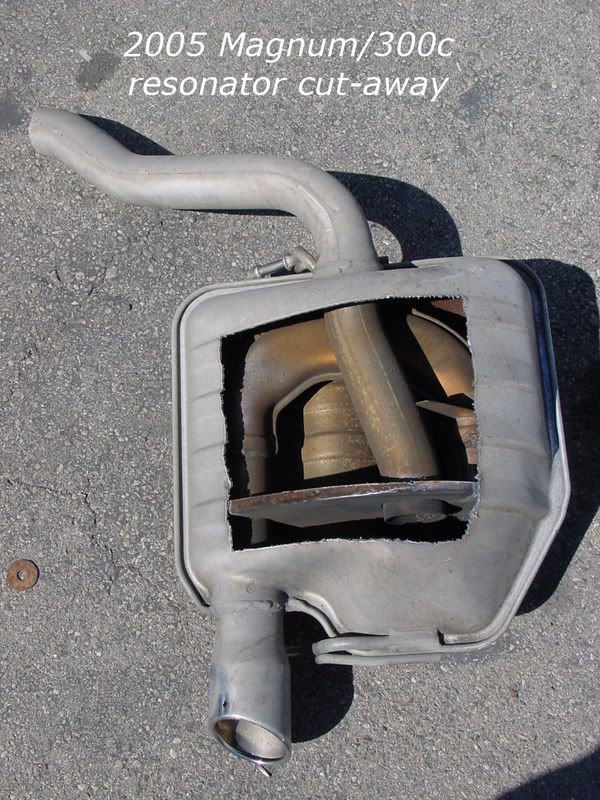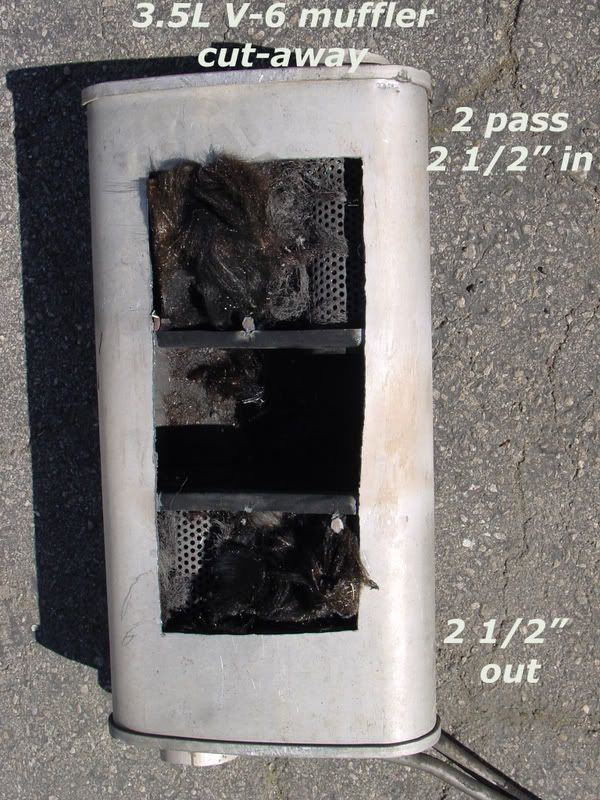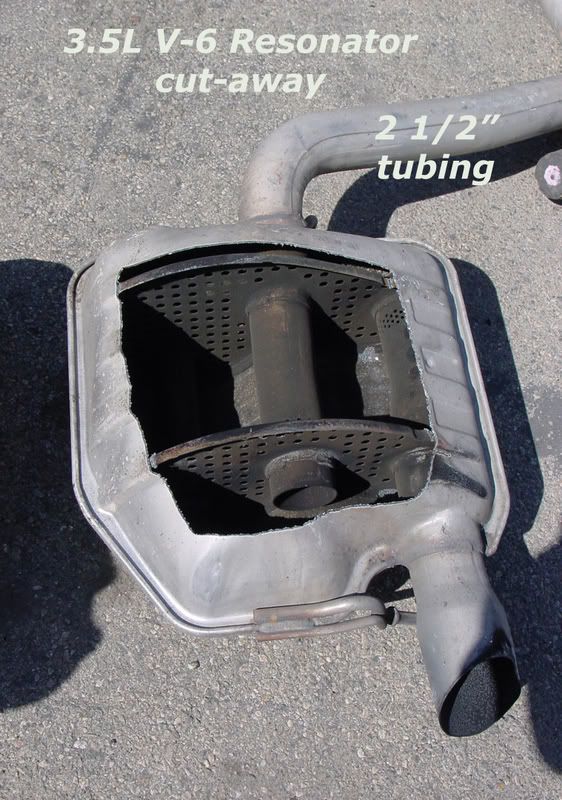all i'm need to say is back in 2008 one member posted dyno results of R/T exhaust, vs his aftermarket setup and stock.
he started with 174hp, with R/T he went down to 169, afterwards with a custom crush bent econo setup he was at 183, when we went to mandrel it went up to 186.
this was done on a dyno indoors, over a period of a week, not a track where conditions can change and you have done NO testing with elimination of variables. thats the beauty of dyno testing a single car, you try and remove as many variables as possible.
When I first bolted it on, yes I took a slight hit on gas mileage and it felt a little more sluggish out of the hole
sluggish things are NOT efficient. it takes more power to get things moving, and less power go to the wheels. basic working of a car or anything mechanical. with basic boltons you should feel a gain right off the bat. proves my point.

but once the PCM adaptives kicked in it was right back where it was prior to the exhaust.
further proves my point.

the engine now has to adapt to doing more work to make the same power. once again, less efficient. wastes more energy to get the same amount of work.... LESS EFFICIENT

remember, resetting adaptive only gives you a feel of improvment with all the fuse pullin and stuff. you reset something is something has gone awry and you want or need it to learn from the start. else modern computers adapt as its driven. ***Nail in Coffin ALERT***
but even without all that, you added something mechanical and it lost power,got sluggish. if it improved it, the minute it went on, you shoulda felt a boost in performance RIGHT FROM GO. obviously some exceptions are boost, nitrous setups, etc.. but all basic boltons are, are parts the allow whats already there to work more efficiently. it doesnt really produce more power, it allow the engine to work more efficiently and put more power to the wheels.
when i added headers, it didnt feel sluggish, it actually had a good surge when i stepped on the gas. when i added my exhaust, same thing, even noticed a bit more chirps off the line at stop lights. why? because it was more efficient than what i started with.:clap:
It's not about a single mod when you start modifying things, but the combo of parts.
your absolutely right! f'in totally agree with you. but think of this... how many weak links do you wanna put in your setup. thats how i view modding. example: if i'm gonna run boost down the road. why would i rebuild the bottom end with a forged crank, forged piston and economy rods? whats my weak link when i reach 15psi now? food for thought....marinate.


Is the Daytona exhaust the most efficient for my car? Probably not, but I'm not saying it is. Is it better than the stock V6 exhaust which uses the same muffler and resonator design as the R/T exhaust? IMO, yes it is.
you're right on the first part... it isnt.
is is betther than the stock v6...your dead wrong. the stock exhaust does a better job at keeping the exhaust hot and flowing.
what the goal of a performance exhaust? to evacuate gasses as quickly as possible. EFFICIENCY. it does this by way of keeping them hot. so when you have TWO banks of an engine, 6 cylinders flowing hot gases into 2.5 inches all the way back
or you can have 3 cylinders flowing into an exhaust thats actually longer more open chambers that slow exhaust down even further and a variety of different sized pipes ranging from 2 inch to 2.25 to 2.5 inch. remember one of the factors of backpressure is caused by slow stagnant exhaust gasses. engines trying to push more out, while slow flow backs things up.

you just said the R/T and v6 use the same exact muffler and resonator design? OMGWTFBBQsauce baby! :shocked: you are so wrong there.:nono: I'll post cut open pic of all so there is NO confusion on which is what....resonators are similar if not the same on the outside. but inside, they are quite a bit different.
V6 muffler is a 2 pass muffler of sorts. comes in, streams to the other side, straight out.
V8 suitcase muffler is a 3 pass, meaning it has to pass through 3 different sections not to mention make 2, yes TWO 180 degree turns... by now we should know the straightest line is the fastest. they did this because the v8 is a much more LOUDER engine and has a larger need to QUIET IT DOWN more than the v6... more open areas to cool down the exhaust pulse charge.
on this alone, you saying the mufflers are the same....you're opinion is shot due to physical construction the pictures show, and just simple reasoning of how things work. remember the suitcase does the same thing on both sides, two 180 degree turns... the v6 muffler is one shift towards the left, almost straight through of sorts... pictures are proof. like i said, somethings you;ve said, i agree with, but on this, I NOR YOU NOR CAN ANYONE DISPUTE FACTS.
lets look at the resonators...this is kinda a draw in my view. the designs are significantly different on the inside:
Daytona...comes through the 2.25 pipe then has to SQUEEZE by the sides of that plate the pipe is held up by. remember its already slowed down the intensity/velocity from the suitcase... now its squeezes by the plate and into an open chamber where it has to flow into the U shaped pipe which its opening is 1 inch by 3 inches wide (so they could fit it in there). Both end of this U are welded to 2 inch (not 2.25 or 2.5... TWO INCH!)tubing which eventually opens up to the exit of 2.5 inches..
V6 Resonator... 2.5 inches IN AND OUT!!!

however, heres the "hmmmmm drawbacks" of it... it comes in, but then has to flow through those many holes towards the rear, then out the pipe on the right. so basically in through the middle, down the grids through the open areas, slowing the exhaust pulses down cause remember open areas are bad for performance with hot gases involved, then out the 2.5 pipe.
but overall...the v6 exhaust keeps it at 2.5 inches through the ENTIRE system. it doesnt split it off here and there, and keep changing the pipe sizes. only in the resonator does it make the exhaust actually make a two 180 degree turns. you do that 4 times in the daytona or R/T setup....two in the suitcase, two in the resonator.
And from what I've seen on both here and LXf, my 9.85 1/8 time is one of the best times posted for a 3.5L with just a CAI, different exhaust, and Diablo tune. Even when "corrected" for D/A for the night it was run
you said a stock v6 with a tune. you got a CAI in addition to all of that. wouldnt have been a fair comparison...

more airflow via a free-er flowing filter and smoother intake tube

you're sneaky! :biggrinjester:
So if weather or track conditions were the big factor, I know for a fact that there are a lot better tracks out there that people have run on that generally produce some of the best numbers and they are still not running 9.85s. I ran my truck the same night and got personal best ETs for it's set up but I was easily faster in my truck running at Sac Raceway in Cali in a worse DA. I'm not some spring chicken who has only raced at one track and my Charger isn't my first car I've taken to a track. I'm not saying I'm a pro either and feel that if I had time to get more runs in the night I got the 9.85 I would have been able to get an even better time. And according to more than one person the CAI I am running is actually hurting my low end torque. And I got that time running the Diablo 93 tune with no tweaks to fuel or spark.
like i said, i posted a 300+ hp car, with 270 tq...vs your cai, exhaust and tune and
you were only 0.1 seconds slower in 1/8 mile.
-did he run at a "good track" or a "bad track"?
-was it a good track on a bad night?
-was it a bad track on a good night?
-what other cars with v6's run at the track or your track that you can compare.
-whats the wear and tear on their engines vs yours?
too many factors/variables etc.... plus i hate bench racing:bigthumb:
but like you said, you ran your truck the same night and posted personal bests....well obviously it was a GREAT night for you at the track. the track was good, you had good traction, prob some nice cool dense air where it was cool enough to get good power, but not cool enough to cool the track down and mess up traction.
you ran what you ran, but that has no bearing on testing one part, especially since you have more than one aftermarket part working to get you that 9.85 you're proud of, AND SHOULD BE.:beerchug:
I've never seen your "CAI" but honestly, unless its severely undersized, like inertia motorsports has already TESTED and STATED the intake manifolds are our restrictions on the intake side of things. prob not your "CAI" unless you just got a filter hanging there in a hot area with no heat sheild...then initially when you hit the gas, you're takin in hot air before you get to moving a bit where things cool down as you go...
but in the end you can only compare your times fully stock vs now if you wanna compare parts. you added intake, exhaust, and a tune, then ran what you ran... two guys with the same car go by the exact same parts and one is faster...what do you legitamently tell them? goes to show, two cars with the same parts can do different times and numbers.
thats why i stick to posting facts about how things work, and back it up with links, documents, pics, proof, to why they work like that... and sometimes even video...
37 seconds in the video...
in the end, you went the way you did, and thats fine. if your happy, more power to you... but if anyone is interested in getting the most performance as possible, dont waste time taking step backwards just to pass back by that point going forwards. simple logic and reasoning.











